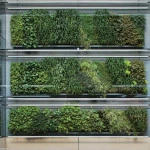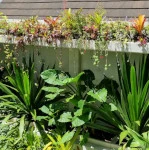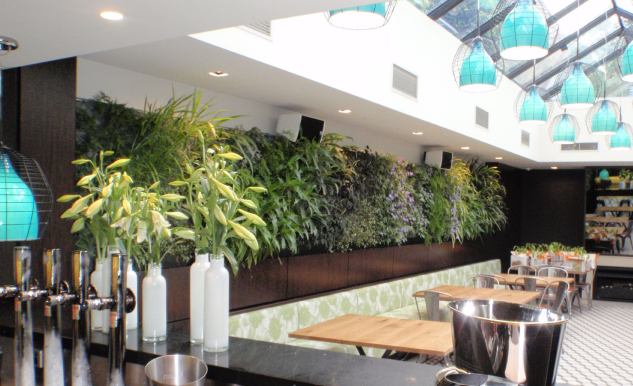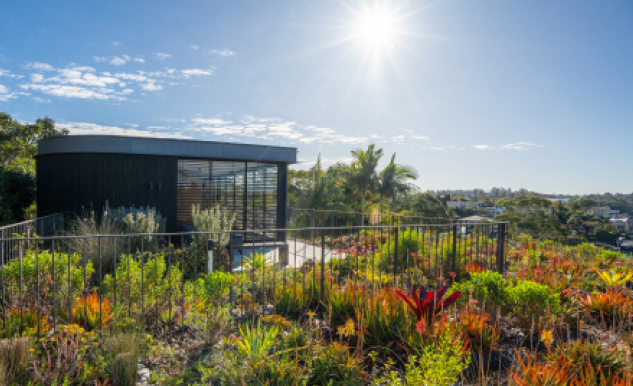5 Essential Tips for Indoor Vertical Gardens
Elevate Your Indoor Space
Green walls, also known as living walls or vertical gardens, have taken the world of interior design by storm, bringing the beauty of nature into our indoor spaces. These living artworks not only add a touch of lush greenery but also offer a myriad of benefits, from improving air quality to promoting a sense of well-being. If you’re considering creating an indoor greenwall, we’ve got you covered with five essential tips to ensure your vertical garden thrives and becomes a stunning centrepiece in your home or office.
- Mastering the Art of Lighting
You may not know, but light is the lifeblood of plants. Providing the correct lighting is vital for the success of your indoor greenwall and research has shown that plants need the right spectrum of light to effectively photosynthesise, which directly impacts their health and growth. Before you invest in and indoor greenwall you you’ll need to assess the lighting required and then invest in specialised grow lights or work with natural light sources to ensure your plants receive the illumination they need to thrive. This is measured in Photosynthetic Photon Flux Density (PPFD) and as a rule of thumb, a minimum of 35 PPFD is required for plant health, with some species requiring more. Healthy plants mean happier people, as the greenery contributes to a more positive and calming atmosphere.
- Tailoring to Your Indoor Environment
Selecting the right plants for your greenwall is crucial to its long-term success. Collaborate with greenwall professionals and horticulturists who understand the unique requirements of your indoor space. Remember, there’s no such thing as a typical “indoor plant.” Only some plants can tolerate lower light conditions, so be flexible with your planting palette and trust the expertise of your horticulturist. The right plant selection will ensure your indoor greenwall flourishes and remains a captivating sight year-round. Peperomia genus is an example of a versatile, resilient low light tolerant genus to work with.
- Maintenance as a forethought
Think ahead and engage those who will be working on your systems in early concept design phase. There is still a lot of misconceptions in the markets as to how greenwalls can be maintained. Adequate space to maintain, safely and efficiently are key. Increasing the height of your greenwall beyond a safe ladder distance (can be as low as 2.5m, depending on the environment) means you will need to consider maintenance from ropes or an Elevated Work Platform (EWP).
- Breathing Life into Your Vertical Garden
In nature, plants benefit from natural air movement, which facilitates CO2 reduction and helps disperse vital nutrients. In order to mimic this natural air flow in your indoor greenwall to promote plant health and create a dynamic living environment, we work with you. This may involve directing aircon ducts toward the greenwall to enhance air circulation or creating a more conducive growing environment via additional elements. It’s important to that proper air flow will increase access to light for plants lower on the wall, ensuring every part of your greenwall thrives.
- Setting the Foundation for Success
The choice of growing media is fundamental for the longevity and health of your vertical garden. Media with organics are great on the ground, and do offer a large range of plant varieties but know the media will break down overtime and need replacing, increasing your maintenance cost (OPEX). We will only ever use inorganic growing media, which does not break down over time, while micronutrients provide a stable and nourishing foundation for your plants. Plus our patented media leads the way in sustainable practices, using 95% recycled material, something no one else can claim. By choosing environmentally friendly options, you contribute to a greener future while ensuring your greenwall flourishes for years to come.
Indoor greenwalls are more than just a decorative addition to your space; they bring life and vitality to your surroundings. By mastering the art of lighting, selecting the right plants, planning for the future, ensuring proper air flow, and using sustainable growing media, you can cultivate a flourishing indoor oasis that uplifts your environment and enriches your well-being. Embrace the beauty and benefits of greenwalls, and let nature’s magic thrive within your walls.






